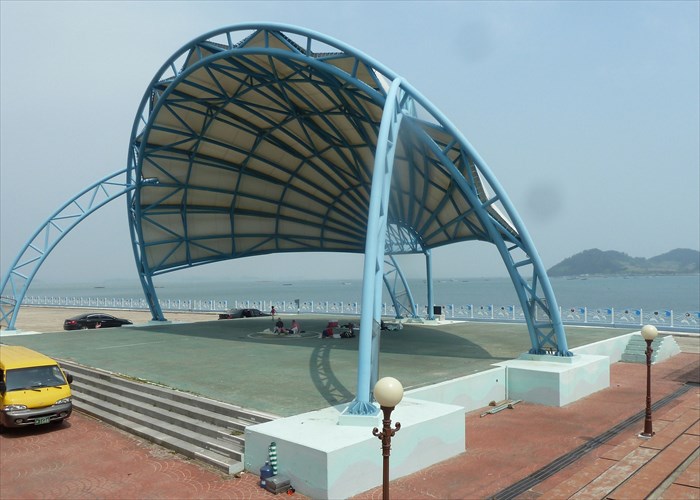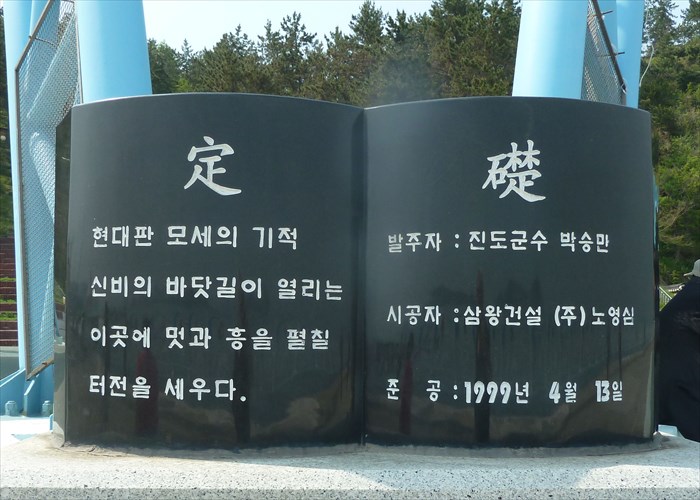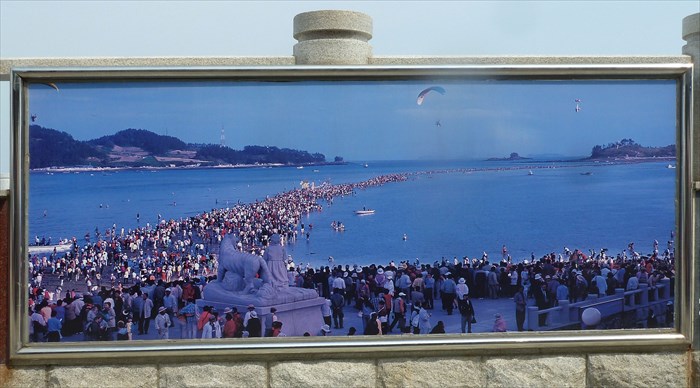
The seats for this amphitheater are simply made up of stones going up the natural slope of a hill facing east with a view of the island of Modo and the land bridge which opens up. Crowded together, there is probably room for many thousands of people. There is a wooden stage under a large shell-shaped canopy. Behind the stage is a monument engraved with a statement of the location and details of the construction of this amphitheater.

현대판 모세의 기적
신비의 바닷길이 열리는
이곳에 멋과 흥을 펼칠
터전을 세우다.
발주자 : 진도군수 박승만
시공자 : 삼왕건설 (주) 노영심
준공 : 1999년 4월 13일
[This stands at the place of the modern, mysterious Moses Miracle
where the land bridge opens up bringing a sense of wonder and awe.
Director: Jindo County Commissioner Park Seung-Man
Constrction: Samwang Construction Co., No Yeong-shim
Construction Date: April 13, 1999]
The road here is closed to vehicles, but there is a small parking area beside this amphitheater. It is a pleasant walk of about a kilometer up to the place where there is a crossing from this island, Jindo, to a smaller island, Modo, which miraculously appears twice a year. All of the western and southern coast of Korea is subject to large variations between low and high tide, often creating large mud flats. Here, at the extreme low tides that occur only twice a year, a strip of rocks are exposed, forming an arched road nearly 3km (1.75 miles) long, and from 40-60m (130-200 ft.) wide. It is open for only a few hours at these rare times.
Although there are other similar land bridges along the coast, this one is unusually long and spectacular, with a legend going back hundreds of years surrounding a figure known as Grandma Bbong (or Ppong. The pronunciation is with a tensed "b" sound and a long "o." Bbong means "mulberry," but her name is never translated this way.
There is an annual festival held during the spring, usually during March or April, when the opening occurs. It has become such a novelty that as many as a quarter million people gather here, many making the crossing. Some Christians have adopted this phenomenon, calling it the "Moses Miracle" for its reminder of the parting of the Red Sea as Moses lead the fleeing Israelites across dry land in front of Pharaoh's pursuing army. Foreign tourists also come here in large numbers for the spectacle and the festival.
At the Jindo side of this natural bridge there is a large granite statue of Grandma Bbong with a tiger, and interpretive signs. (Depicted on the right side of this arch, and in the photo below). Further south is another small statue of her, and at the south entrance of the road there is more of a shrine in her honor, a large outdoor amphitheater and a larger parking area.

The Legend of the Sea-Parting Miracle
The Story of Grandmother Ppong
In 1480, near the beginning of the Joson Dynasty, Son Dong-ji was condemned to exile on Jeju Island. During his voyage to the Island the ship was wrecked during a storm ans Son drifted ashore at a place named Hoedong or Tiger place because of the many tigers in the area. Son and his descendents lived in Hoedong for over 200 years. Life was hard and villagers were frequently attacked and killed by the tigers. Finally, Son’s descendents took a raft and moved to the nearby island of Modo. However, and elderly woman named Grandmother Ppong was accidentally left behind. The old lady longed to be reunited with her family and prayed for help night and day to the Dragon King of the Sea. Then one night, early in March, the Dragon King appeared to her in a dream and told her to cross the sea by walking on the rainbow that he would provide for her. When she awoke she ran to the sea and once again prayed to the Dragon King. Immediately, a rainbow-shaped opening appeared in the water between Hoedong and Modo. Grandmother Ppong immediately started out over the rainbow path, but the exertion was too much for her and she collapsed. Her family, crossing the rainbow from the other side, found her and as she died in their arms, she said, I am happy because the Dragon King has reunited me with my family. The people of Jindo Island still perform the annual ritual in remembrance of the sea-parting miracle and Grandmother Ppong, and many come here to pray for their children and the people love and that their wishes come true.

진도 신비의 바닷길 뽕할머니 이야기
국가명승 제9호
진도군 고군면 회동리
의신면 모도 사이 28km
조선조 초기 손동지라는 사람이 제주도로 유배도중 풍파로 이곳에 표류하여 마을을 이루고 살게 되었는데 호랑이의 침입이 심하여 마을앞 모도라는 섬으로 피신을 하면서 황망중에 뽕할머니 한분을 남겨두고 말았다.
뽕할머니는 마을 사람과 가족을 만나게 해달라고 매일같이 용왕님께 기원하였더니 바닷길이 열려 마을사람과 가족들을 만나게 되었으나 그 자리에서 숨을 거두고 말았다. 이때부터 해마다 음력 3월이면 마을 사람들은 이곳에서 풍어와 소원 성취를 기원하는 영등제를 지내고 회동과 모도리 사람들이 바닷길 현장에서 서로만나 바지락등 조개를 줍고 해산물을채취하며 하루를 보낸다.